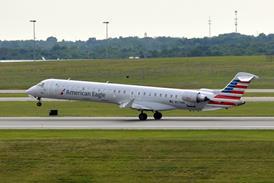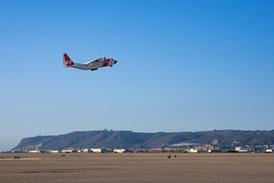Could the next generation of quiet, long-range supersonic transports emerge from work beginning for the US military?
Graham Warwick/WASHINGTON DC
Apollo it is not, but the US Defense Advanced Research Projects Agency's (DARPA) new Quiet Supersonic Platform (QSP) programme sets challenging goals that will require breakthroughs on several fronts. And the integration skills that took man to the moon will be needed to bring together innovative technologies and achieve the equally distant objective - a low-boom, long-range aircraft capable of unrestricted supersonic flight over land.

"We do not see any 'silver bullet' solution," says Dr David Whelan, director of DARPA's Tactical Technology Office. "But it might be possible to make improvements in many different areas that add up to a real net improvement." Not interested in incremental improvements, the agency has set out a "very dramatic set of goals" for QSP and challenged industry to "think out of the box".
Congress has given DARPA $35 million to spend over two years on QSP studies. Not a lot, given the aggressive goals, but enough to determine whether there are low-boom designs worth pursuing. By the end of two years, "we are looking for validated concepts for boom reduction," says Whelan.
DARPA has identified three potential military roles for a quiet, efficient supersonic aircraft: a reconnaissance vehicle; a medium bomber; and a high-speed transport. "There is no stated requirement for any of these," cautions Whelan. Instead, DARPA "is using its license to explore beyond requirements".
Commercial potential
Take the high-speed transport, for example. "Is there an evolving need to transport high-value military equipment globally in a crisis, say if a command and control centre needs parts urgently?" asks Whelan. While the "most immature" of the military roles, the high-speed transport is the one most closely aligned with the requirements for a supersonic business jet. "There is potential for a commercial offshoot," he agrees. "There are obvious synergies and potential industry interest."
Large size makes solving the sonic boom problem harder, so DARPA wants to keep the aircraft small and make it efficient. To guide industry, the agency has established an outline specification for a 45,500kg (100,000lb)-class aircraft with a Mach 2.4 cruise and 11,000km (6,000nm) range. The payload fraction, typically only 5-8% of a supersonic transport's gross weight, has been set at 20% - "the same as a [Northrop Grumman] B-2," Whelan says.
Other QSP performance goals include a supersonic lift-to-drag ratio of 11, engine thrust-to-weight ratio of 7.5, specific fuel consumption of 1.05lb/lb/h (30g/kNs), competitive subsonic performance and compliance with Stage 3 noise limits. These are only objectives, however: the single requirement of the QSP programme is to reduce sonic boom ground signature initial shock strengths to no more than 0.3lb/ft2 (1.9mbar/m2).
"Together, these goals stretch well beyond current supersonic transports," says DARPA programme manager, Dr Richard Wlezian. As sonic boom and performance are intimately tied to aircraft weight, meeting the stated goals will require a reduction in gross weight of more than 30%. "If we can do that, we will have an interesting capability," he says.
The QSP goals have not been plucked out of the ether. "We have worked with NASA and the USAir Force to come up with numbers which make sense and are self-consistent," Wlezian says. "In our view, the numbers are reasonable given the state of the technologies, but still well off the projected trend lines."
Initial shock
The sonic boom target is based on NASA research which indicates that an initial shock strength of 0.5lb/ft² is the upper limit for public acceptance of unrestricted supersonic flight over land. This is "untested", Wlezian admits. Acknowledging the aircraft "may not always fly supersonic, saving speed for when it's needed," he says requiring good subsonic performance is an "escape valve" for the programme.
Other objectives are based on the results of DARPA-funded studies into advanced configurations, such as Reno Aeronautical's supersonic laminar flow aircraft. This features an extremely thin wing with low sweep and sharp leading edge which naturally sustains laminar flow over most of its surface. Reno claims its design can reduce supersonic drag by 50% and increase lift-to-drag ratio by 30% compared with a conventional turbulent-flow delta wing.
Last year, the Carson City, Nevada-based company completed a DARPA-funded study of a M2.4 reconnaissance unmanned air vehicle with a gross weight of 25,000kg and a range of "well over" 11,000km, says president Richard Tracy. Independently, Reno is studying a M1.5 business jet with a 45,500kg gross weight and 11,000km range.
Deliberately, DARPA has structured the QSP programme to encourage small businesses to participate. "We are trying to get the traditional players to think out of the box and to bring in people with new ideas on an equal footing." says Wlezian. To achieve this, the programme has been split into three.
The first part of QSP technology development is targeted at universities, small businesses and other entities with innovative ideas for sonic boom reduction. The second is looking for advanced propulsion concepts and is aimed at the engine manufacturers. The results of these efforts will be brought together in the third part of the programme, in which the airframe prime contractors will perform system studies to evaluate the effectiveness of the technologies in a conceptual low-boom vehicle and produce a fully validated, integrated design.
"We anticipate real innovation in the first [part]," says Wlezian. DARPA's research announcement (RA) cites several potential direct and indirect means of reducing sonic boom, including airframe shaping, flow control and weight reduction. Concepts include foamed metallic structures incorporating cooling passages to promote laminar flow.
The propulsion RA seeks engine concepts offering long-range, sustained supersonic cruise performance with reduced take-off and landing noise. DARPA is looking for bypass ratios up to 5 to reduce noise and increase efficiency, and says aspirated compressors could enable lightweight fans to be used while monolithic ceramics could reduce core size. Inlets and nozzles with active flow control will also push performance, Wlezian believes.
Candidate concepts
Candidate 'breakthrough' technologies will be evaluated in conceptual designs under the third RA, which has been structured so that system integrators "will not get by doing business as usual," stresses Whelan. Work in all three areas is expected to begin in December.
In addition to supersonic laminar flow, potential concepts cited by DARPA include an oblique flying wing. Lockheed Martin, meanwhile, has patented a flying wing design that combines a sharp-edged, flat-topped aerofoil which reduces shockwave strength with a plenum system which ejects sheets of air that reflect shockwaves back to reduce drag.
Other unconventional ideas have been proposed, including heating or ionising the airflow around an aircraft to increase the local speed of sound. But Dr Richard Seebass, professor of aerospace engineering sciences at the University of Colorado, wrote the book on boom reduction theory and believes "there is only one technology that works - aircraft shaping". Anything else is "good imagination and bad physics". He is more impressed by another Lockheed Martin design for a supersonic transport combining several features to reduce sonic boom. These include a conical nose to "stretch" the forward shock; a long-chord, high-sweep wing to spread lift along the aircraft's length; and an inverted-V tail to brace the wing and reduce weight. "This is a nice structural design."
Such closely coupled aerodynamic, acoustic, structural and propulsion design will be essential if the QSP goals are to be met, Whelan says. "The solution will have to be the integration of multiple technologies."
Source: Flight International























